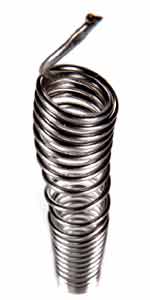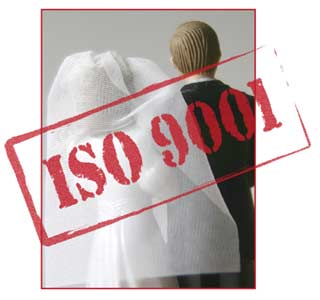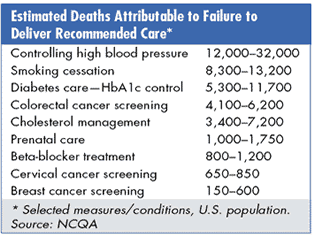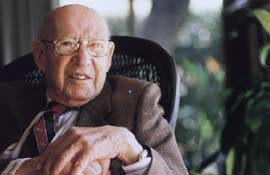Get the Lead Out
U.S. electronics manufacturers have a new enemy No. 1: lead.
With the deadline for compliance with the Restriction of Hazardous Substances (RoHS) directive just six months away, electronics manufacturers all over the world are preparing and, in many cases, revamping, their manufacturing techniques. RoHS was passed by the European Commission in 2003 and prohibits the use of certain substances in electrical and electronic equipment--including components--exported to or made in Europe. It takes effect on July 1, 2006. The substances to be banned are:
 The near-total prohibition of the banned substances (lead, mercury, hexavalent chromium, PBB and PBDE are limited to 1,000 parts-per-million, and cadmium is limited to 100 ppm) is causing serious problems at electronics-manufacturing facilities all over the world. The near-total prohibition of the banned substances (lead, mercury, hexavalent chromium, PBB and PBDE are limited to 1,000 parts-per-million, and cadmium is limited to 100 ppm) is causing serious problems at electronics-manufacturing facilities all over the world.
• Lead
• Mercury
• Cadmium
• Hexavalent chromium
• Polybrominated biphenyls (PBB)
• Polybrominated diphenyl ethers (PBDE)
Electronics manufacturers are most concerned about the banning of lead, which is widely used in solder alloys and to connect electronic components.
"At this point, I'd say the state of the industry is somewhere between panic and chaos," says Stan Salot, president of the Electronic Components Certification Board. In some cases, compliance could require laborious piece-by-piece inspection because the directive prohibits the presence of the banned substances not just in finished products but also in components and parts. Because many manufacturers have outsourced components manufacturing, the process of ensuring that each piece is RoHS-compliant will be a huge, and still somewhat unsolved, problem.
Another European Commission requirement passed simultaneously with RoHS, the Waste Electrical and Electronic Equipment (WEEE) directive, requires that electronics manufacturers work to prevent the waste of electrical and electronic equipment, increase recycling, and start meeting waste collection and treatment targets immediately.
Sanmina-SCI Corp., a global electronics---manufacturing organization, has been planning for RoHS compliance for years. Sanmina-SCI has a longstanding "green" policy and has been shipping lead-free assemblies to certain Asian customers for more than 18 months.
"We're working up process maps to assess exactly where we are companywide with compliance," says Susan Hughes, Sanmina-SCI vice president for corporate quality. "It's difficult because it requires that we also assess our suppliers."
The "greening" of the electronics-manufacturing industry has been a long time coming. The ECCB released its hazardous substance-free specification--commonly referred to as EIA/ECCB-954--earlier this year to give manufacturers a framework in which to ensure compliance.
"Manufacturers have been reducing the amount of hazardous substances in their products for years," says Salot. "It's just now that we're making this very technical process more formalized."
Accordingly, hazardous substance-free certification is likely to be the wave of the future for the electronics-manufacturing industry. SigmaTel Inc., an Austin, Texas-based producer of integrated circuits, recently became the first company in the world registered to EIA/ECCB-954. The company was audited by National Standards Authority of Ireland.
Still, there's a great deal of confusion about how to ensure RoHS compliance. "So far, there's no shortage of data from vendors," writes Ed Sperling of ElectronicsWeekly.com. "Volumes are being created by vendors across the supply chain, and most of that data is highly accurate and detailed. But in some cases, it's still incomplete or just plan wrong, creating a liability nightmare for every company whose components will be used in an end product, as well as those that manufacture it…. An OEM, for example, can be sued for not checking the parts sufficiently, potentially dragging the entire cast of suppliers into a lengthy legal battle and greatly adding to their operating cost structure."
For more information, visit www.rohswell.com, www.electronicsweekly.com or www.iecq.org.
 Quality in Love Quality in Love
An Indian matchmaking company has announced its registration to ISO 9001.
Kaakateeya Marriages Private Ltd. maintains a database of more than 70,000 marriage-minded adults. The company, based in Hyderabad, India, was established in 1981 and today has 25 branches with 300 employees. Members can choose to post their profiles online or at the company's regional offices. There are upward of 20,000 profiles posted at the Hyderabad office alone.
ICL Certification Ltd. performed Kaakateeya's audit, which examined its management, commitment, planning, responsibility, quality of human resources, infrastructure and work environment, among other characteristics. The company is the only Indian matchmaking company registered to ISO 9001.
For more information, visit www.kaakateeya.com.
Health Care Quality Increases
A report recently released by the National Committee for Quality Assurance shows that health care quality improved significantly in 2004. Enrollment in health care plans that publicly report care information, however, has declined.
 These findings are part of NCQA's annual "The State of Health Care Quality" report, which was produced in conjunction with U.S. News & World Report magazine. Among 289 commercial health plans that reported their data, the average performance improved on 18 of 22 clinical measures. Medicare and Medicaid reported smaller gains. The report shows that as many as 67,000 deaths were prevented as a result of quality improvements during the past six years. These findings are part of NCQA's annual "The State of Health Care Quality" report, which was produced in conjunction with U.S. News & World Report magazine. Among 289 commercial health plans that reported their data, the average performance improved on 18 of 22 clinical measures. Medicare and Medicaid reported smaller gains. The report shows that as many as 67,000 deaths were prevented as a result of quality improvements during the past six years.
Especially notable were improvements in measures related to the control of high blood pressure and cholesterol. About 67 percent of patients have their high blood pressure under control, up 4.6 points from the previous study. Cholesterol control for people with diabetes is up 4.4 points to 64.8 percent.
The improvements found in the report are enjoyed by about 64.5 million people, the number covered by publicly reported plans. This represents a decline of 4.5 million from a year ago, due largely to shifting enrollment patterns. Enrollment in PPOs and high-deductible, consumer-directed health plans is up sharply, and these plans tend not to measure or report on their performance, which could threaten future gains.
"Any kind of health plan might potentially be an excellent plan," says Margaret E. O'Kane, NCQA president. "But realistically, only the ones that measure quality are going to achieve excellence."
The printed version of the report ranks 50 commercial, 25 Medicare and 25 Medicaid health plans. The rankings are based on clinical performance, member satisfaction and NCQA accreditation information. Respectively, the top five commercial health plans in the report are: Harvard Pilgrim Health Care (Massachusetts), Harvard Pilgrim Health Care of New England (New Hampshire), Preferred Care (New York), Tufts Health Plan HMO (Massachusetts) and Tufts Health Plan POS (Massachusetts).
To view the entire report, which includes more plans than the print version, visit www.usnews.com/healthplans.
 In Memoriam: Peter F. Drucker In Memoriam: Peter F. Drucker
Peter F. Drucker, one of the most influential management theorists of the 20th century, died November 11 at his home in Claremont, California. He was 95 years old.
Drucker's career as a writer, consultant and teacher spanned nearly 75 years. The author of more than three dozen books, Drucker pioneered the ideas of privatization and the corporation as a social institution. He coined the terms "knowledge workers" and "management by objectives." His groundbreaking work turned management theory into a serious discipline.
Most recently, Drucker was the Marie Rankin Clarke Professor of Social Sciences and Management at Claremont Graduate University, where he wrote and consulted until the time of his death.
Good Software Development Pays
Best-in-class software development projects not only make it to market faster than competitors, but they're significantly less expensive as well.
 Those are the findings from Quantitative Software Management Inc., which surveyed 536 information technology (IT) software-development projects from 31 companies in 16 countries over the course of four years. The research found that best-in-class projects are 3.37 times faster to market and 7.48 times cheaper than worst-in-class producers. When compared to "average" software producers, the top producers are 1.86 times faster to market and 2.72 times cheaper. From a quality perspective, the best-in-class projects encountered 10 or fewer defects during testing, while average-performing projects had 50 defects. Worst-in-class projects experienced 253 defects--more than five times the defects of the average project. Those are the findings from Quantitative Software Management Inc., which surveyed 536 information technology (IT) software-development projects from 31 companies in 16 countries over the course of four years. The research found that best-in-class projects are 3.37 times faster to market and 7.48 times cheaper than worst-in-class producers. When compared to "average" software producers, the top producers are 1.86 times faster to market and 2.72 times cheaper. From a quality perspective, the best-in-class projects encountered 10 or fewer defects during testing, while average-performing projects had 50 defects. Worst-in-class projects experienced 253 defects--more than five times the defects of the average project.
The costs and duration of projects associated with being "best" or "worst" were similarly dramatic: The build phase of a best-in-class software project lasted about 3.6 months and cost about $200,000. Worst-in-class projects took a year to complete and cost $1.4 million. The total life-cycle costs were also meaningful: just above 7.5 months and $300,000 for best-in-class software development, and upward of two years and $2.2 million for worst-in-class projects.
According to the research, the most significant factors influencing best-in-class performance are:
• Controlling requirements change
• Highly skilled people with good functional knowledge of the application domain
• Effective tooling
• Effective project leadership resulting in low staff turnover
"Controlling change is the most important element to successful development projects," says Doug Putnam, QSM Inc. managing partner. "An inability to adroitly manage change can be the enemy of productivity and quality. Effective leadership creates a culture where change is well-managed by highly skilled teams with good domain knowledge."
"It may seem ironic that, while tools are always a significant factor as productivity drivers, they ranked only third as an influencing factor for the quality of the projects," says Michael Mah, QSM Associates managing partner. "The study drives home the point that, despite its technology focus, software development in the end is a people activity. There can be no technology substitute for training and management."
The typical IT software- development project release was comprised of 30,000 new or modified source lines of code, or 600 function points. The total project duration was 13.5 months, building up to a peak of 7.4 full-time people and consuming 55 person-months of effort.
QSM Inc. provides tools and services for software-development professionals. For more information, visit www.qsm.com.

That's Hot!
How's this for a quality nightmare? A server at your restaurant spills hot soup all over a patron's lap. If you've planned for a situation like this, it doesn't have to be a fiasco, says Ken Levine, who preaches the gospel of service-recovery planning. Make arrangements with a nearby dry cleaner, and keep a robe, books and television in a private room. When disaster strikes, offer to have the clothes dry cleaned--at your expense--and back to the customer in 20 minutes or less.
Read more by clicking the "Root Cause Analysis Takes Too Long" headline at www.qualitydigest.com/sixsigma.
AutoTech 2006 Cancelled
The Automotive Industry Action Group has announced that it will cancel next year's AutoTech trade show. The next AutoTech won't be held until May 2007, and the venue hasn't yet been announced.
"To avoid overlap with other automotive events, AIAG has determined that May would be a better month to hold AutoTech, and a new, state-of-the-art venue was selected for the conference, but it is unavailable in 2006," says J. Scot Sharland, AIAG executive director. "In the meantime, AIAG will be upgrading and increasing the number of informational and educational town halls, conferences, seminars, sessions and summits held throughout 2006 for each of AIAG's key areas: collaborative engineering, electronic commerce, materials management, quality, occupational health and safety, and trucks and heavy equipment."
The Awards Dinner for 2005 recipients will he held in April or May, at a venue to be announced.
For more information, visit www.aiag.org.
Quality Excellence in Canada
 The National Quality Institute recently announced 14 recipients of the 2005 Canada Awards for Excellence. The National Quality Institute recently announced 14 recipients of the 2005 Canada Awards for Excellence.
The CAE Quality Award is based on the Canadian Framework for Excellence, used by many organizations as a management model for continuous improvement and the achievement of operational results. The Quality Award winners are:
• 3M Canada Co., London, Ontario--Gold Trophy
• NuComm International, St. Catharines, Ontario--Gold Trophy
• Xerox North American TeleWeb, Saint John, New Brunswick, and Dartmouth, Nova Scotia--Gold Trophy
• Telus,Vancover, British Columbia--Gold Trophy
• Real Estate Board of Greater Vancouver, Vancouver, British Columbia--Silver Award
• Purolator Courier Ltd., Mississauga, Ontario--Bronze Award
The CAE Healthy Workplace Award winners are:
• Homewood Health Centre, Guelph, Ontario--Gold Trophy
• Buffett Taylor & Associates Ltd., Whitby, Ontario--Gold Trophy Small Business
Three organizations received Customer Service Awards in the small-business category, which recognizes excellence in companies with fewer than 50 employees. The recipients are Print Audit, Calgary, Alberta; Vennego Inc., Toronto, Ontario; and Vubiz Ltd., Mississauga, Ontario.
CAE Education Awards were presented to R.H. King Academy, Scarborough, Ontario (Gold Trophy); Vincent Massey Public School, Ottawa, Ontario (Silver Award); and St. Luke Catholic Elementary School, Mississauga, Ontario (Silver Award).
"These organizations may be vastly different in their missions, but they are all characterized by unparalleled excellence in their management practices," says Cameron Hyde, NQI chairman. "By investing in quality processes and healthy workplace practices, they achieved impressive results in 2005."
The awards were formally presented Oct. 20 at the CAE Awards Gala Dinner in Toronto. Paul Martin, Canada's prime minister, made the keynote address and introduced the award winners.
For more information, visit www.nqi.com. |